|

by Christopher
McIntosh
New Dawn
Special Issue,
Vol. 16,
No 5
October
2022
from
NewDawnMagazine Website
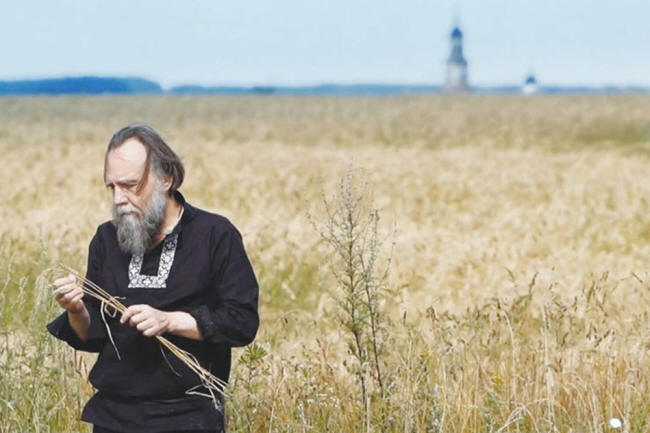
Russian philosopher
Alexander Dugin
Russia gets into your blood. It got into mine when I studied Russian
at the United Nations Language School in New York in the
1980s and 90s while working as a UN information officer, having
already learned the basics when I was 19.
I can still hear our teacher Alla coming into the classroom
and saying:
"Today, my dear
students, we going to study our beautiful Russian verbs - first
the imperfective and then the perfective verbs."
Who could fail to fall in
love with Russian verbs with such a charming teacher?
If you happen to read
this, Alla, I send you a big wave. But it was not only the verbs...
Other intricacies of
Russian grammar intrigued me, rules like,
"don't forget that if
the verb is negative the noun has to be in the genitive."
And the beautiful
Cyrillic alphabet would dance before my inner eyes.
Then there was my Russian
girlfriend around the same time, who told me that,
"to sound like a
Russian you must smile inwardly when you speak."
Indeed, they do this even
when they are conveying something sad or, more likely, sad and funny
at the same time - a combination at which the Russians excel.
Russian literature, too, captivated me.
I became familiar with
Dostoyevsky's Idiot, Andrei Bely's extraordinary
novel Petersburg and the equally extraordinary Master and
Margarita by Mikhail Bulgakov.
Reading these works, one
becomes aware of the deeply spiritual nature of the Russian soul.
Furthermore, these last
two authors revealed another side to Russia that intrigued me,
namely a strong current of fascination for things magical, esoteric
and other-worldly.
I decided to go deeper
into this domain, and my latest book
Occult Russia was the result.
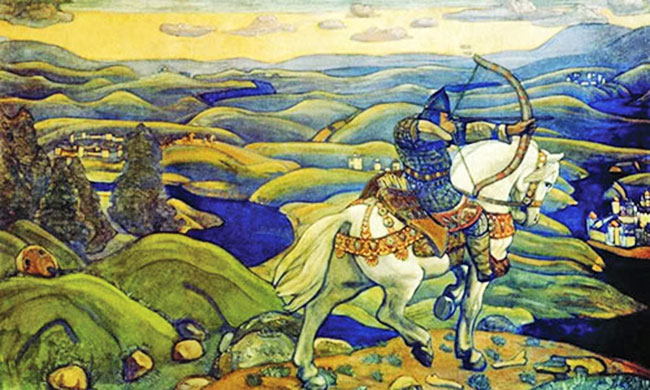
'Ilya Muromets' (1910)
by
Nicholas Roerich.
Of course, I was devastated when the war in the Ukraine began, and I
feel deeply for all my Russian and Ukrainian friends.
As I write I can only
pray that the conflict will not be prolonged. As a stop-press item,
I must express my deep outrage and sadness at the death of
Alexander Dugin's daughter Darya who was killed on 20 August
2022 by a car bomb possibly intended for her father.
Through this cowardly
act, the life of a radiant human being has been tragically cut
short.
My deepest sympathy
goes out to all her family.
I offer the book
Occult Russia in the hope that it will contribute to a deeper
understanding of the Russian mind and soul.
What follows is a
foretaste of it, abridged and edited from the Introduction...
• • •
Upon hearing the word "Russia" you may think of,
military parades in
Red Square, the war in the Ukraine, the annexation of the
Crimea, gangsters, internet hackers, assassinations of
journalists and imprisonment of opposition politicians...
This book is not about
those things but about a different Russia that is invisible to many
people in the West - namely the inner Russia, the Russia of
mysticism, myth, magic, the esoteric and the spiritual.
Like a vast river, long
ice-bound, the spiritual force deep in the Russian soul is moving
again.
In the wake of the
collapse of communism, the Russian people are seeking new - or often
old - ways of giving meaning to their lives. This search has given
rise both to a revival of ancient spiritual traditions and to a
plethora of new movements, cults, sects, -isms and -ologies, most of
which would have been banned in the Soviet era.
Out of this ferment
exciting things are emerging.
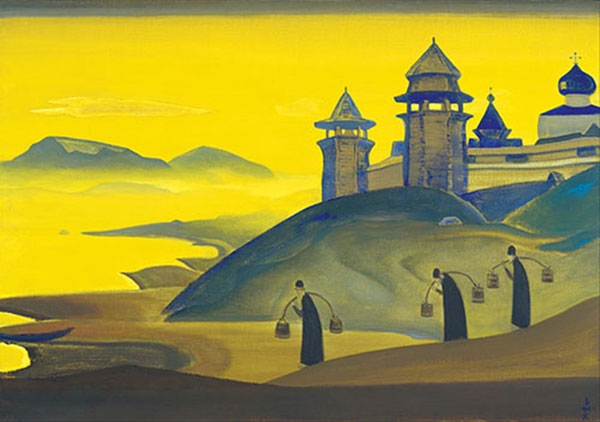
'And We are Trying' (1922)
by Russian artist and Eurasian mystic
Nicholas Roerich.
Today's spiritual quest in Russia covers an enormous spectrum.
Millions are turning or
returning to the Orthodox Church, and thousands of new churches are
being built. As for alternative forms of spirituality, many people
are turning to doctrines such as Theosophy, Anthroposophy and the
teachings of Nikolai and Helena Roerich.
Another group is turning
back to the pre-Christian gods of Russia or to
shamanism, often of the variety practiced by the urban
intelligentsia.
Meanwhile the indigenous
pagan communities such as
the Mari and the various shamanic
peoples of Siberia are enjoying a new lease of life.
In Russia the shamanic
and pagan traditions have long existed side by side with the
Orthodox religion - if not always in peaceful co-existence at least
in a modus vivendi that the Russians call dvoeverie
(dual faith).
History can be driven by mythical motifs, and this perhaps applies
particularly strongly to Russia. One useful term for such a motif is
the word "meme," coined by the British biologist Richard Dawkins
in his 1976 book 'The
Selfish Gene.'
Originally used in the
biological context, it has come to mean an idea or notion that
spreads like a message through a society, transmitted from person to
person or through the media.
A phenomenon with some similarities to the meme, but operating at a
deeper level, is that of the egregore, a collective
thought-form on the invisible plane, created by many people focusing
on the same ideas and symbols.
Deriving from a Greek
word meaning "watcher," an
egregore can take an infinite
variety of forms:
an angel or demon, a
god or goddess, a hero or heroine, an object of special
veneration, a sacred place or a compelling narrative...
The concept of the
egregore overlaps to some extent with the notion, developed by
the psychologist Carl Gustav Jung, of the archetype,
an inherited motif in the collective unconscious of humanity.
In exploring Russia's
mystical quest we find various powerful memes, egregores
and archetypes at work.
They include the
following:
Holy Russia
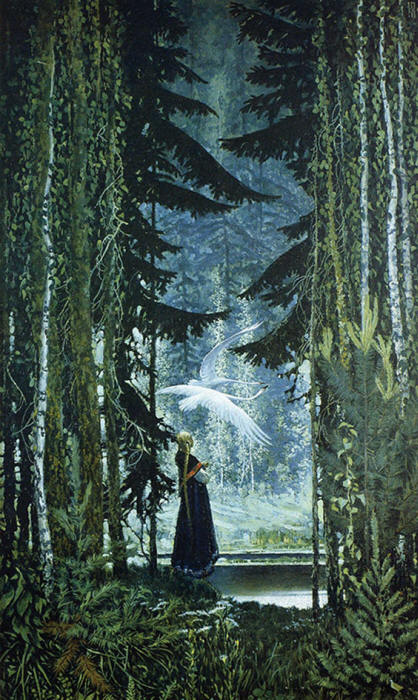
Geese
by Konstantin Vasilyev
The notion of Holy Russia is searchingly explored by Gary
Lachman in his book of that title.
Deeply engrained in
the Russian collective soul is the conviction that Russia has a
special spiritual mission. This is reflected in the powerful
mystique of the Orthodox Church and the concept of the "Third
Rome":
the first Rome
being the city on the Tiber, the second being Constantinople
and the third and final one being Moscow.
All of this has given
rise to an egregore of enormous vitality, which has
enabled the Orthodox religion to flourish anew after the
communist era.
The Warrior
Hero
An early example of this figure is the semi-legendary Ilya
Muromets, who features in various Russian epics as well as
in films, novels and art.
Probably a composite
of various different people, he appears as a defender of Kievan
Rus in the 10th century and in later incarnations he
fought the Mongols and saved the Byzantine Emperor from a
monster.
He eventually became
a saint of the Orthodox Church.
The role of the
warrior hero has also been played by certain real historical
figures such as Prince Alexander Nevsky who defeated,
the Teutonic
Knights in the thirteenth century, Tsar Peter the Great, and
even Joseph Stalin...
The
Never-Never Land
This motif crops up repeatedly in Russian history in various
forms and under various names:
-
Byelovodye
(Land of the White Waters)
-
Opona, the
utopia of peasant folklore
-
Hyperborea,
the vanished promised land in the north
The Never-Never
Land is also thought of as the source of an ancient wisdom
tradition that has the power to transform human life if one
could only access it.
The
Rustic Sage
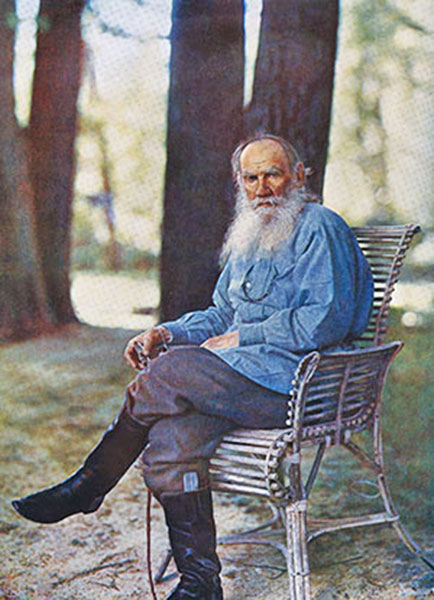
The
rustic sage,
Lev
Tolstoy,
pictured
at Yasnaya Polyana, 1908,
in
the first color photo portrait in Russia.
This figure is typified by Tolstoy's character of
Platon Karataev, the wise peasant who is a fellow
prisoner of the hero Pierre Bezukhov in War and Peace.
Tolstoy himself
adopted this persona in his later years.
The Holy
Fool
Alternatively "fool for Christ," this term is applied to someone
who adopts an apparently mad way of life, marked by great
austerity and extreme piety.
It can overlap with
the concept of the starets, the independent, god-illuminated
holy man or woman.
It has been pointed
out to me by my correspondent Dana Makaridina that there
are two kinds of holy fool, namely,
The distinction is
subtle.
The former are
characterized by a state of saintly bliss, whereas the
latter are conspicuous by their craziness and weird,
antisocial behavior.
Both are associated
with freedom, being unconstrained by any social norms and able
to communicate directly with God.
Dana Makaridina
mentions a friend who has had the nickname blazhennyi
since childhood because of his strange, otherworldly behavior.
She writes that,
"now he is an
extravagant rock musician and performance artist dealing
with topics of freedom and death."
The New
Messiah
Prophets and messiah figures have abounded in Russian history,
overlapping somewhat with the starets and the fool for
Christ, and they continue to appear in the present day.
A typical example is
the case of Sergei Anatoljewitsch Torop, an artist and
jack-of-all-trades who, in 1991, proclaimed himself to be
Jesus Christ returned.
Adopting the name
Vissarion, he founded a community called the Church of
the Last Testament, gathered several thousand followers and
established an eco-spiritual settlement in Siberia.
At the time of
writing he is in prison facing a charge of extorting money from
his followers and subjecting them to emotional abuse.
The Woman
Clothed with the Sun
This figure originates in a passage in chapter 12 of the book of
Revelation in the New Testament.
To quote the King
James Bible:
And there appeared a
great wonder in heaven; a woman clothed with the sun, and the
moon under her feet, and upon her head a crown of twelve stars.
This image of the woman
clothed with the sun crops up repeatedly in Russian prophetic
writings.
My own perception of Russia has been through different stages. As
far as I can remember, the country meant little to me until 1953,
when I was nine years old, and one morning at breakfast my father
picked up the newspaper and remarked that Stalin had died.
I may have asked who
Stalin was and been told that he had been the leader of our powerful
eastern ally during the Second World War.
Later I absorbed the Cold War propaganda.
Russia came to mean,
-
the suppression
of the Hungarian uprising
-
defectors from
the West like Burgess and Maclean
-
Khrushchev
banging his shoe on the table at United Nations General
Assembly
-
the Cuban missile
crisis
-
the crushing of
the Prague Spring
-
the persecution
of dissidents...
At the same time I was
fascinated enough by Russia to start learning the language when I
was nineteen years old, a process that I resumed in my fifties, by
which time I had witnessed the advent of Gorbachev and
perestroika, shortly to be followed by the break-up of the Soviet
empire and the collapse of communism itself.
While these tumultuous
changes were going on I visited Russia for the first time in 1991
with an American contingent of very amiable born-again Christians,
whose tour group I was able to join through the facilitation of an
acquaintance.
A particularly vivid memory of that trip was visiting a Russian
Orthodox seminary near Saint Petersburg.
On entering the building
I found myself transported into another world, marked by candlelit
icons, the fragrance of incense and an atmosphere of still
reverence.
There was a quiet dignity
about the priests and seminarists moving about in the dim corridors.
One of them, looking
startling like the photographs I had seen of the wild-eyed prophet
Rasputin, was a young man with long, black hair and a solemn
expression, dressed all in black in a sort of peasant's tunic,
trousers, and boots.
We were shown to the
chapel of the seminary where a service was held, and I began to
understand why Madame Blavatsky, non-Christian though she
was, always vehemently defended the Orthodox Church.
At the present time, in the wake of the collapse of communism, the
Orthodox religion is once again playing a central role in the life
of the nation.
Churches are full,
and thousands of new ones are being built, with the state
playing a supporting role.
But not everyone is happy
with the current situation, and some of the initial post-perestroika
religious enthusiasm is waning.
Many believers oppose
what they see as an increasing tendency towards a merger of state
and Church, while people of other persuasions do not want Orthodox
Christianity to be imposed on the population.
Visiting Russia reinforced my view that it has a special destiny, as
many prophets have predicted. One of them, the German writer
Oswald Spengler, wrote in an essay entitled "The Two Faces of
Russia" (1922):
The bolshevism of the
early years has thus had a double meaning.
It has destroyed an
artificial, foreign structure, leaving only itself as a
remaining integral part.
But beyond this, it
has made the way clear for a new culture that will some day
awaken between "Europe" and East Asia. It is more a beginning
than an end.
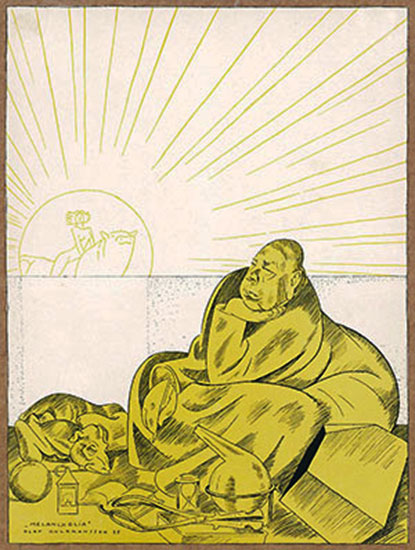
A 1930s
cartoon by Olaf Gulbransson,
caricaturing the German historian Oswald Spengler.
The woman in the background symbolizes Spengler's prediction
that
a new age will come out of Russia.
Property of the Olaf Gulbransson Museum, Tegernsee.
Photograph © VG
Bild-Kunst, Bonn 2022.
Thirteen years later Spengler's vision for Russia was illustrated in
a cartoon by the artist Olaf Gulbransson, which appeared in
1935 in a literary-satirical journal originally produced in Munich
under the name Simplicissimus, but by then published in exile
in Prague under the title Simpl.
The cartoon, entitled
Melancholia, is a parody of Albrecht Dürer's famous
engraving known under the same title.
In the foreground sits a melancholy Spengler, quill pen in hand,
beside an even more melancholy dog and various other objects
including an obstetric forceps, perhaps indicating that the New Age
in Russia will have a difficult birth.
In the background is an
image of the New Age itself in the form of a naked young woman
riding a rather complacent-looking bear, both framed in a large
rising sun.
The woman in the
background riding a bear symbolizes Spengler's prediction that a new
culture will come out of Russia.
Gulbransson's cartoon appeared in 1935 during a troubled time.
Germany had been through a military defeat, followed by the ravages
of inflation and depression and then by the Nazi seizure of power in
1933.
In Russia the Bolsheviks
ruled. Another war was on the horizon.
But Gulbransson pictured
a bright future coming from the direction of Russia and symbolized
by the maiden riding the bear.
Between then and now
there are certain parallels. The present era is overshadowed by war
and by high tensions between Russia and the West.
But I believe the maiden
riding the bear still carries a hopeful message.
References
|







